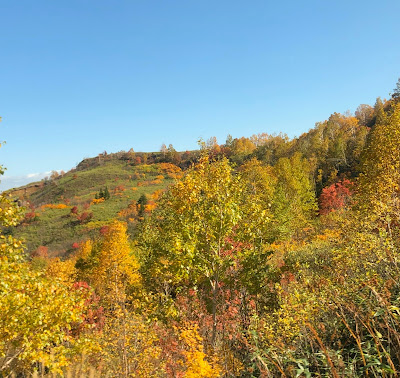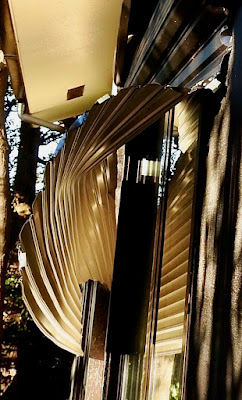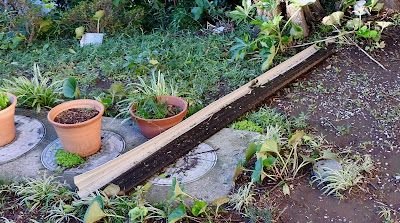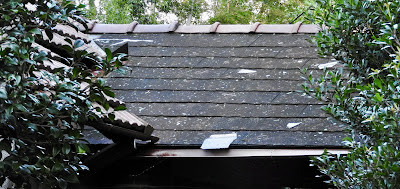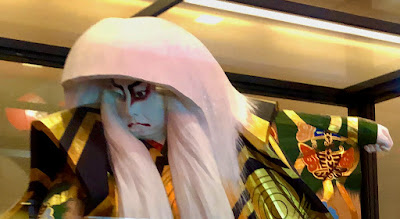目次 / Contents
1) 日本国内旅行 / Japanese Domestic Trip
2) 東北 / Tōhoku
3) 悲しい消失 / Sad Disappearance
A. 松川渓谷 / Matsukawa Gorge
B. 八幡平 / Mount Hachimantai
4) 追記 / Postscript
1) 日本国内旅行 / Japanese Domestic Trip
ここ何年かは、日本国内旅行はツアー (団体旅行) を利用しています。
私が海外での自分でやりくりする、夫Rとの、個人旅行に疲れるので、せめて国内では楽になりたいと思うからです。
多くの方が感じるツアーの良いところと悪いところがあり、それは
私 (達) も同様です。
のんびりやの私達はいつもツアーは、慌ただしいです。
ですがRはそれに '満足感' を抱くようです。
そのことに私が気がついた時は、びっくりもしましたが、日頃の彼の行いを返り見ると納得もしました。
彼は、値段の安さを含めて、かなりツアーが好きです。
9月に帰国後、初めての国内旅行は、紅葉の旅;東北旅行でした。
Rの誕生日旅行のつもりで、クラブツーリズム主催の、この旅行
(下の画像) を選びました。
Japanese Domestic Trip
For the past few years, I have been using tours (group trips) for domestic travel in Japan.
For the past few years, I have been using tours (group trips) for domestic travel in Japan.
Because I was tired of individual trips, with my husband R, that
I organize overseas, I want to have trips more easily, at least in Japan.
There are pros and cons to tours that many people feel, and so do
I (us).
As a laid-back person, tours are always busy.
But R seems to be 'satisfied' with them.
I was surprised when I realized that, but I was convinced when
I looked back on his daily activities.
He likes touring quite a bit, including the low prices.
After returning to Japan in September, our first Japanese domestic trip was a trip to see Autumn Colours ; a trip to Tōhoku.
I chose this trip from Club Tourism as R's birthday trip, above.
2) 東北 / Tōhoku
Rはもちろんですが、私は東北にあまり馴染みがありません。
旅行先としても行ったことがあまりありません。
しかも今回のように東北地方を巡る旅は初めてでした。
福島県の6県です。
これら6県で、本州の約3割の面積を占めることを初めて知りました。
 |
| 濃い緑 : 東北地方 Deep Green Part : Tōhoku 画像は下記より/ This from below ★ |
 |
| 東北6県 青森県、岩手県、秋田県、 宮城県、山形県、福島県 Tōhoku 6 Prefectures Aomori, Iwate, Akita, Miyagi, Yamagata and Fukushima. 画像は下記より/ This from below★ |
Tōhoku
Not to mention R, I'm not very familiar with Tōhoku.
I hadn't been there much as a travel destination.
Moreover, this was my first trip around the Tohoku region.
For the first time, I found out that these six prefectures occupy about 30% of the area of Honshu.
 |
| 15日の日程 Itinerary,15th in Japanese |
3) 悲しい消失 / Sad Disappearance
A . 松川渓谷 / Matsukawa Gorge
松川渓谷の中の '森の大橋 'は、観光スポットで、私達は、そこへ行きました。
紅葉は同じ場所でも、その進み具合で景色が違います。
私達が訪ねた時、松川渓谷は'紅葉'という言葉通りの顔でした。
色彩豊かな山々とカーブを伴った川の景色が融合され、
「うわ〜っ!」
と素直に感動しました。
優しい印象のカーヴが折り重なって、日本の山中では珍しい景色かと思いました。
通常、写真に映らない私も、ガイドさんに頼んで、私と夫Rの写真を撮影していただきました。
もちろん、私も美しい景色を何枚も撮影しました。
'森の大橋 'からの景色は優しい印象でしたが、松川渓谷の渓谷内では、切り立った玄武岩と紅葉の組み合わせが感動的な場所があるようです。
Matsukawa Gorge
The "Big Bridge of the Forest : Mori no Ohashi" in the Matsukawa Gorge is a tourist attraction, and we went there.
Even in the same place, the autumn colours change, and the scenery will be different depending on the progress.
When we visited, the Matsukawa Gorge, indeed, showed the word 'Autumn Colours'.
The scenery of the colorful mountains and the river with curves was interwoven
"Wow!"
I was honestly impressed.
The gentle impressions of the curves overlapped, and I thought I hadn't often seen this kind of scenery in the mountains of Japan.
I do not usually have my photograph taken, but here I asked our guide to take a photograph of me and my husband R.
Of course, I also photographed many beautiful scenes.
The view from the Bridge : "Mori no Ohashi" was a gentle impression, but I heard that there seems to be a place in the Matsukawa Gorge where the combination of steep basalt and autumn colours is impressive.
B. 八幡平 / Mount Hachimantai
次の観光スポットの八幡平 (ハチマンタイ) でした。
八幡平の山域は、十和田八幡平国立公園 (トワダハチマンダイラコクリツコウエン)に指定されています。
私達は山頂近くの駐車場で、短い散策時間をもらいました。
限られた時間にどれだけ山登りができるか...不安でした。
現場の地図 (下の画像) に、歩く目安の時間が書かれていました。
与えられた時間のギリギリかなと感じました。
鏡沼は、雪解けの、5月後半から6月初旬にかけて、"ドラゴンアイ" が見られます。
(現在、BBCのその番組がYouTubeにアップロードされています→ ★)
「これは私たちが行った場所!」
と思い当たりました。
私達が訪ねた鏡沼とは全く違った景色がそこにはありました。
私のブログの更新が(かなり)遅れているので、ここに書くことができました。
鏡沼を見て戻ってきた後に、集合時間まで少しあり、違う方角の景色を見ようとしました。
そこの駐車場の一部が工事中で、係の方が私とRを誘導してくれました。
その方は私達を手招きし呼び寄せて、駐車場の地面に作られた、出来立ての秘密の (?)ハートマークが描かれている場所を教えてくれました。
八幡平は、紅葉には少し早かったのですが、前日が非常に冷えたので、ごく一部、木にツララ(樹氷?) を見ることができました。
山々の景色の中で、ツララが光って綺麗でした。
山登りの最中に出合ったハイカーのツアーのガイドさんが、
「運がよければ、今日は樹氷が見られる」
と説明していました。
私達はラッキー!
自然は不思議です......紅葉はまだなのに、ツララは見ることができる....。
八幡平と松川峡谷の景色は素晴らしく、紅葉の旅はとても良いスタートを切りました。
通常の旅行では、PCを持ち歩き、その日の撮影はPCに入れています。
ですがこの旅行ではカメラしか持っていませんでした。
海外旅行で撮影した写真の整理が溜まっていたので、カメラに収まる枚数のみ撮影しようと思ったからです。
また、最近では、i-phoneのカメラも使用します。
初日の晩は疲れて、ホテルの部屋で写真の整理ができず、翌日のバスの中で整理を始めました。
揺れるバスの中で、間違って、15日(初日)の写真を全てと翌日16日の八甲田ロープウェイでの写真を失ってしまいました。
なので、このセクションに載せる自分の写真が一枚もありません....悲しい....。
まあ、写真の整理が溜まっている私をちょっと助けることにはなりました...と自分を慰めるのです。
 |
| 鏡沼周辺の地図 Map around Kagaminuma - Pond 画像は下記より/ This from below ★ |
Mount Hachimantai
The next tourist attraction was Mount Hachimantai (Hachimantai, Iwate).
The mountainous area of Hachimantai is designated as Towada-Hachimantai National Park : ★.
In a car park near the summit, we were given a time for a short walking.
I was worried about how far we could climb the mountain in the limited time.
Their local map, above shows the estimated walking times.
I felt that getting to the summit was too difficult in our given time.
"I don't overdo it", we didn't go to the summit and turned back at Kagaminuma-Pond.
In Kagaminuma-Pond, "Dragon Eye" can be seen, from the latter half of May to the beginning of June when the snow melts.
After visiting Kagaminuma-Pond, I found out about it in a BBC program online
about "Dragon Eye" : ★ .
(Nowadays the BBC program has been uploaded to Youtube → ★)
"Isn't this the place we went!"
I realized.
The view of "Dragon Eye" looked completely different from the Kagaminuma-Pond we visited.
I have been (quite) late in updating my blog, so I was able to write this here.
After seeing Kagaminuma-Pond and returning, there was a little time until the meeting time, and we tried to see the scenery in a different direction.
A part of its car park was under construction, and a staff in charge guided I and R.
He beckoned us over to the place where a secret (?) Heart mark had just been set in the ground in the car park.
Hachimantai was a little early for the autumn colours, but the night before was very cold so I could see the tiny remains of icicles on a tree (rime on trees?).
In the scenery of the mountains, the icicles were shining and beautiful.
A hiker tour guide I met while walking up the mountain, was explaining to his hikers
"If you're lucky, you can see rime today."
We were lucky!
Nature is mysterious ... I could see icicles here even though the autumn leaves haven't visited yet ...
The sceneries of Hachimantai and Matsukawa Gorge, were wonderful, and the trip to the autumn colours had made a very good start.
Usually on a trip, I take my PC and transfer the photographs for the day onto my PC.
However, I had only my camera for this trip.
When traveling abroad, I have accumulated many photographs, so
I decided to only take as many photographs as I could fit in my camera.
Recently, I also use i-phone camera.
I was so tired on the first night that I couldn't organize my photographs in the hotel room, so I started organizing them on the bus the next day.
In the swaying bus, I accidentally lost all photographs of the 15th (first day) and the photographs on the Hakkoda Ropeway of the 16th, the next day.
So I don't have any of my photographs for this section .... sad ....
Well, it helped me a little, because I accumulate many photographs, unorganized ... comforting myself.
4) 追記 / Postscript
私は、私のカメラから写真を失ってしまいましたが、ブログをアップした後に、Rが彼の i-phoneで撮影した写真を見けました。
ここに載せます。
Postscript
I lost photographs from my camera, but after posting my blog, R found his photographs which he took by his i-phone.
I will put his photographs here.
 |
| 岩木山 バスの中から撮影 岩木山は、標高は1,625 mで、青森県の最高峰です。 Mt. Iwaki Taken from inside our coach Mt. Iwaki is at an altitude of 1,625 m, it is the highest peak in Aomori prefecture. |
松川渓谷 / Matsukawa Gorge
 |
| "森の大橋" から From "Big Bridge of the Forest : Mori no Ohashi"  松川 / River Matsukawa  とてもきれいな紅葉の景色でした。 These were very beautiful views of the autumn colours.  R、ありがとう! R, Thank you very much! |
バスから / From Coach
 |
| 左の影は、撮影中の私。 The shadow on the left is me during photography. |
 |
岩木山周辺 / Around Mt. Iwaki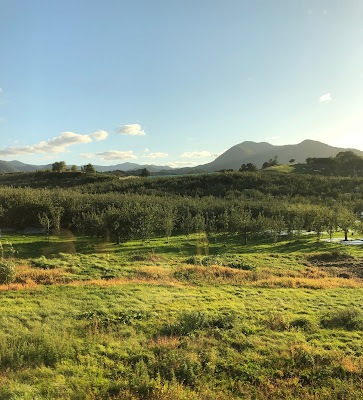  |



